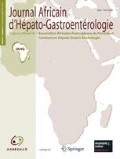Résumé
La duplication de la vésicule biliaire est une malformation congénitale rare, qui survient dans environ 1 sur 4 000 naissances. Sa fréquence est de 1 sur 12 000 cholécystographies et de 1 sur 4 000 autopsies. Sur le plan anatomopathologique, Boyden a élaboré une première classification en 1926, modifiée par Skandalakis et al. en 1972; elle sera alors classée en six formes. Elle est due à un bourgeonnement exubérant au niveau de l’arbre biliaire lors de la division du bourgeon caudal du diverticule hépatique. Nous rapportons un cas rare de duplication de la vésicule biliaire, découvert en période néonatale au cours d’un ictère par l’échographie abdominale et la TDM abdominopélvienne. Les cas rapportés dans la littérature concernaient des adultes découverts à l’occasion de cholécystectomie, les cas décrits chez le nourrisson ou l’enfant sont rares, chez le nouveau-né aucun cas n’a été rapporté à notre connaissance, d’où l’originalité de ce cas.
Abstract
Duplication of the gallbladder is a rare congenital malformation, which occurs in about 1 in 4,000 births. Its frequency is 1 in 12,000 cholecystographies and 1 in 4,000 autopsies. Histologically, Boyden first developed a classification in 1926; it was modified in 1972 by Skandalakis, who classified it into six forms. Duplication of the gallbladder is due to a budding at the biliary tree during the division of the hepatic diverticulum. We report a rare case of duplication of the gallbladder, discovered in the neonatal period of jaundice by abdominal ultrasound and abdominal CT scan. The cases reported in the literature of duplication of the gallbladder were adults discovered during cholecystectomy. Infant or child cases are rare; in newborns, no case has been reported to our knowledge, making our case original.
Références
Boyden E (1926) The accessory gallbladder: an embryological and comparative study of aberrant biliary vesicles occurring in man and domestic mammals. Am J Anat 38:177–231
Skandalakis J, Gray S, Ricketts R (1972) The extrahepatic biliary ducts and the gallbladder. In: Skandalakis J, Gray S (eds) Embryology for surgeons. Williams & Wilkins, Baltimore, Md., pp 296–333
Pitiakoudis M, Papanas N, Polychronidis A, et al (2008) Double gallbladder two pathologies: a case report. Acta Chir Belg 108:261
Gross RE (1936) Congenital anomalies of the gallbladder: a review of one hundred and forty-eight cases, with report of a double gallbladder. Arch Surg 32:131–62
Lamah M, Karanjia ND, Dickson GH (2001) Anatomical variations of the extrahepatic biliary tree: review of the world literature. Clin Anat 14:167–72
Sénécail B, Nonent M, Patin-Philippe L, et al (2000) Aspects échographiques des anomalies congénitales de la vésicule biliaire. J Radiol 81:1591–4
McDonald KL, Lwin T (1986) Sonographic and scintigraphic evaluationof gallbladder duplication. Clin Nucl Med 11:692–3
Nouira F, Taieb C, Hela L, et al (2011) Duplication of gallbladder. Tunis Med 89:798–9
Matar M, Ayoubi JM, Picone O (2014) Mise au point: pathologies de la vésicule et des voies biliaires foetales. J Gynecol Obstet Biol Reprod 43:581–6
Kinoshita LL, Callen PW, Filly R, et al (2002) Sonographic detection of gallbladder duplication: two cases discovered in utero. J Ultrasound Med 21:1417–21
Sifakis S, Mantas N, Koumantakis G, et al (2007) Prenatal diagnosis of gallbladder duplication. Ultrasound Obstet Gynecol 30:362–3
Gerscovich EO, Towner D, Sanchez T, et al (2011) Fetal gallbladder duplication. J Ultrasound Med 30:1310–2
El Kettani NEC, Dafiri R (2006) Douleurs abdominales chroniques chez une petite fille. Feuillets Radiol 46:375–7
Görkem SB, Doğanay S, Kahriman G, et al (2014) Acute cholecystitis of a duplicated gallbladder with double cystic duct in a 10-year-old boy. Balkan Med J 31:366–7
Author information
Authors and Affiliations
Corresponding author
About this article
Cite this article
Es-Seddiki, A., Agouni, I., Benameur, S. et al. Une cause rare d’ictère néonatal : la duplication de la vésicule biliaire. J Afr Hepato Gastroenterol 11, 190–192 (2017). https://doi.org/10.1007/s12157-017-0738-4
Published:
Issue Date:
DOI: https://doi.org/10.1007/s12157-017-0738-4

